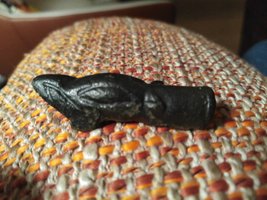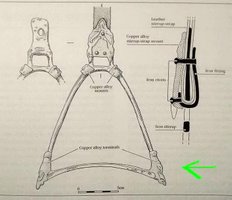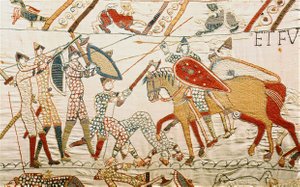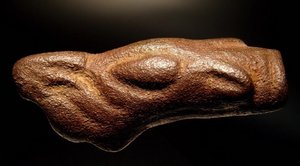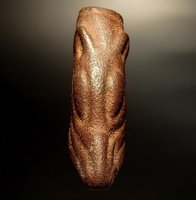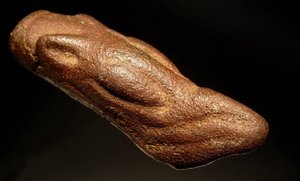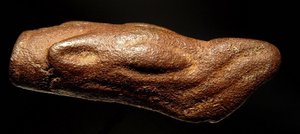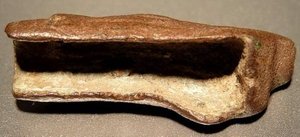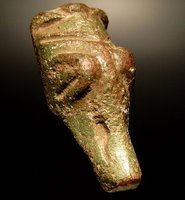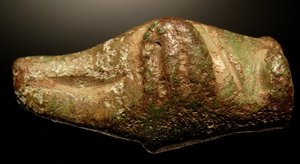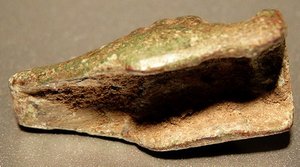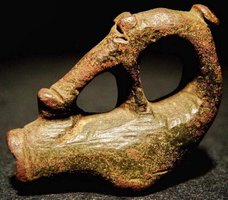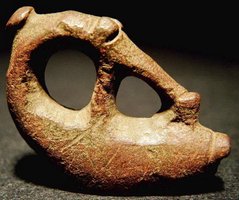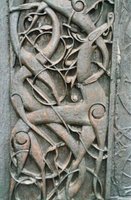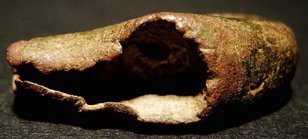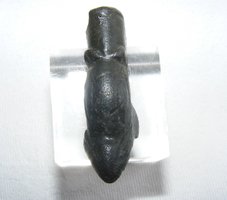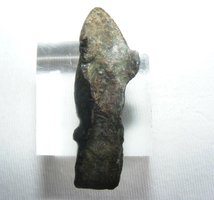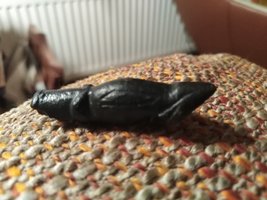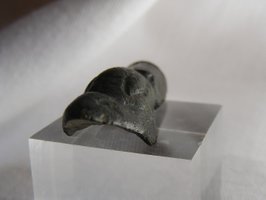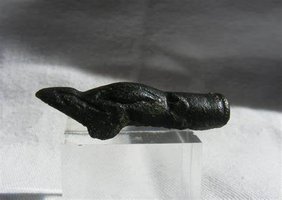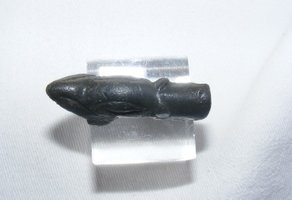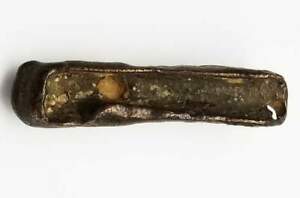Anglo-Scandinavian stirrup terminal mounts
The stirrup terminal and mount; a quite late introduction.. ?
The stirrup itself was unknown to the Ancient World, and was introduced into England quite late in our history by the Vikings. The word itself derives fro the Anglo-Saxon stigan to mount and rap or rope. The earliest Scandinavian example known comes from a 9th century grave excavated in Norway. The earliest depiction of stirrups in use in England appears on the Bayeux tapestry.
The so called viking stirrups are the earliest appearance of this important piece of riding equipment in Britain. It is argued, from a distribution of known find-spots, that they were not introduced by the Scandinavian settlers of the 9th century but are more likely to relate to the ravaging of the war bands led by Olaf Trygvasson, Sweyn Forkbeard and Cnut the Great during the reign of Aethelred. Two distinctive British classes emerge, derived from north European types, suggesting that they were already being made in this country.
The drawing of the stirrup with stirrup terminal at the top of the blog, shows us that there would have been one of these fittings on each side, and sometimes smaller ones on the top of the edges. Several examples have been found in England with part of the iron stirrup still in place. Stirrup terminals are hollow underside to receive the lower edge of the iron stirrup. The detailling is of quite high relief with raised oval eyes, projecting snout, and a tusk at each side. It may represent a dragon but this design is generally referred to as a "beast" as it has elements of the horse, wolf and boar within its iconography.
The first stirrup terminal (mount) could depict a wolf, although it isn't very clear. The lentoid shaped eyes are echoeing the Urnes style, in an Anglo-Scandinavian manner. The decoration is crude and refined the same time.
The next stirrup terminal mount is almost crocodile-lik in its appaerance.
There is quite a range of different shapes and styles of decoration on these stirrup mounts as the example hereunder clearly shows us, with outspoken Urnes style snout - wich is derived from the interlaced entwined snake/beast foliate motif on the doorpanels of the famous Urnes stavechurch in Norway).
The decoration on stirrup terminals as well as stirrup mounts are showing, Ringerike style elements and Urnes Style elements: two facts indicate a date-range of circa AD 1020 to 1050 for their use, with some areas maintaining them up to about AD 1100.
The final viking stirrup terminal mount is an interesting one also. It is depicting the head and beak of a raven. It can be distinguished on the side where the attachment element to the stirrup had broken off (right image herunder). One could easily oversee this, if looking on the complete side of the stirrup terminal mount (left image hereunder). It measures 37 mm in length and 10 mm in width and was found in England (like all these stirrup terminal mounts). In this case in Norfolk.
It is tempting to link their introduction into England with the increased influence under King Cnut (AD 1016-35) but more detalied study will have (and is, see reference Viking Stirrups from England and their Background) to be undertaken before any such proposal can be advanced seriously.
Another, final, intriguing question from my side is what the specific function would have been from this - vulnerable - objects. Was it in any way protective to the stirrup, like the stirrup mounts on top, protecting the leather strap? Or was it purely decorative or symbolic? Would the 'wearer', i.e. the rider of the horse 'use' the animal depicted on the terminal mount to communicate something, now lost in their meaning?
In any way - stirrup terminal mounts of the Viking Age are an intriguing, easily overlooked, type of artefact in the spectrum of elobarate and heavily adorned objects of use and decoration from the Viking period.
References:
Hammond, Brett, British artefacts Volume 3- Late Saxon, Late Viking & Norman, (2013), chapter 1.9 'Riding equipment', p. 84/85;
Kershaw, Jane F., Viking identities, Scandinavian jewellry in England (2013); p. 5;
McLeod, Shane, The beginning of Scandinnavian settlement in England; The Viking 'Great Army' and Early Settlers, c 865-900 (2014), p.41
Mills, Nigel, Saxon & Viking artefacts (2001), p. 78, Chapter 8 Stirrup mounts & harness fittings;
Murawski, Paul G., Benet's second edition of England & The United Kingdom - Artefacts of England & The United Kingdom Milennium Second edition 2003 AD, p. 319-320;
Owen-Crocker, Gale R., King Harold II and the Bayeux Tapestry, chapter 'Graphic commentary on the horses of the Bayeux tapestry', (2005) p. 99;
Seaby, Wilfred A. and Woodfield, Paul, Viking Stirrups from England and their Background
UK detector finds database, Early Medieval (5th-11thC) » Stirrup fittings see:
http://www.ukdfd.co.uk/ukdfddata/showrecords.php?product=46389&title=stirrup-terminal&cat=110
Saxon harness and strap fittings, stirrup mounts, reigns guides & cheek pieces
see: http://www.colchestertreasurehunting.co.uk/saxonharnessfittings.html
Portable Antiques Scheme
see: http://finds.org.uk/database/search/results/q/stirrup+terminal
Well. I could have been with these stones until after dark, but as my wife wanted to travel on.. well.. I see you again, some day, hogback stones from Gosforth. And if you happen to be there one day, do not forget that monument on the outside...
Further on with the Cumbrian hogbacktour !
In - yes, luckily again in - St. Peter's church in Heysham, there is a truly beautiful hogback stone. The guide told us, it had been studyied by Thor Ewing, a writer, in 2000. in 'Understanding the Heysham hogback' A tenth century sculpted stone monument and its context (link), Thor Ewing tells in detail what he dicovered on the both sides of this hogback stone.
Just being brought in the church as late as the 1970's accompanied with some protest here and there among the church visitors, considered as being a token of old paganism, it had been remarkably nice preserved, and a lot of detail can be seen, still. Truly worthwile a visit.
I had a small debate with the guide in the church if the - zoomorphic, in my opinion - faces on the sides were lions (or hippo's). The guide doubted if the vikings could have known about lions. Well I guess so, concerning the runes on the Ancient Greek lion statue at the Arsenal, Venice. For example. Vikings did travel south..
But when he told me he was doubting the vikings 'discovered' (as the native inhabitants were of course, in the first place) America before Columbus, I decided to rest my case..
One has to know when to start and to end a conversation ..
Just discovered the book in a bookstore written by Geoff Holder - The guide to the mysterious Lake District, I knew there had to be another hogback stone in Lowther, St. Micheal's Church. With a promising image described in the text of 'a naval and a land-based force of shield-bearing vikings above a fish and what might be a coiled sea serpent. On the reverse is a row of female figures with snakes, possibly a representation of the hideous hag Hel'. Wow. If that did not sound as a true pagan promised land ..
Not complaing too much after all we have seen, this visit was the dissapointing one of them all. But if you wife states 'I am happy to have seen them' and I am answering 'Measuring is knowing' and the even more obligate verb 'handling 'if we did not see it at all, we wouldn't have known anything at all of how they were looking' the glass was again half full, at the last day of our journey..
The hogback stone appeared to be just being tolerated within the entrance segment part of the church. As something you never use anymore but you do not throw away - entirely. That sort of feeling emerged when seeing this hogback asylum seekers.. Bed, bath and bread, ás we say in Dutch, but no luxury at all and standing on some outcuts of wood, you would balance the table with at home..
Come on, St. Micheal's Church.. care a bit more of your 'children' !
This hogback stone was moved in the church in 1907. Hogback stones layed partially buried in the churchyard before it was dug up and moved into the church.
The promising depiction of a longship - as certainly can be seen after some studying - see http://vikingminds.co.uk/pages/longship
we have missed !
The stone itself is (157 x 50 x 30 cm) and very worn.
The hogback stones in Cumbria - very diverse in quality, but everyone worth a visit ! Especially on a gloomy day in late October ...
The churches to visit - see photos of resp. St. Andrew's church in Penrith, St. Mary's church in Gosforth, St. Peter's church in Heysham and St. Micheal's church in Lowther.
Did I miss out on another one in Cumbria ? Let me know !
In a next blog I will take you to four - still remaining utterly mysterious- statues 'guarding' the graveyard of St. Andrew's church in Dacre..
For the last blog of October 9th see this link.
References: (as always, links to where the books can be ordered are attached).
Edwards, B.J.N. Vikings in North West England - The artifacts (1998);
Emery, Gordon, CURIOUS CUMBRIA, The Lake District & Beyond: A celebration of Cumbria (2023)
Ewing, T. 'Understanding the Heysham hogback' A tenth century sculpted stone monument and its context ;
Hall, R. Viking Age archaeology in Britain and Ireland (first printed 1990, reprinted with amendments in 1995);
Holder, G. The guide to the mysterious Lake District (2009)
possibly also (as there within the part of Cumbria dealing with Carlisle, the Eden Valley, Barrow-in-Furness, Whitehaven and the west coast is being dealed with)
Holder, G. Paranormal Cumbria (2010)
http://vikingminds.co.uk/pages/longship
